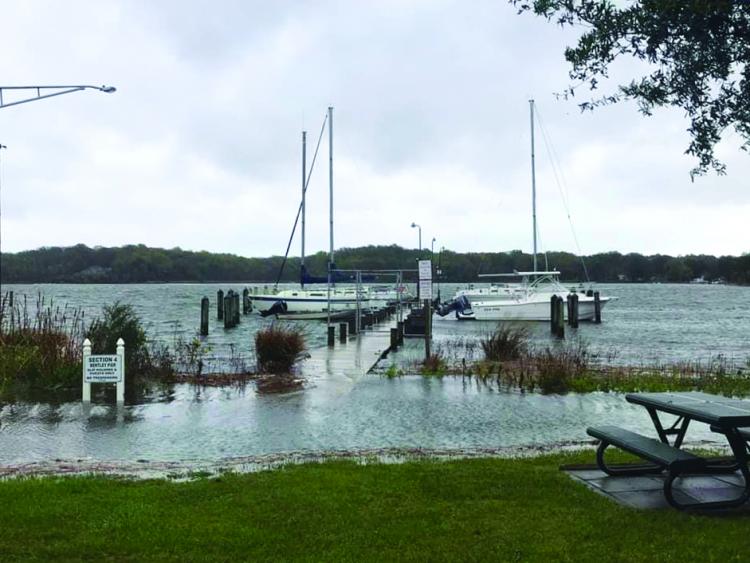Sailing Dinghies at the Boat Park During Flooding and What To Consider
Dinghy sailors have it easy. Big boaters have sleepless nights when a big nor’easter rolls through, wondering if they tied the dock lines just right, or if the fenders are in the right spot. But we go sailing, pull our boats out of the water, cover them up, and know they’ll be all set until the next time we go sailing. But will they?

The extreme flooding event much of the Chesapeake Bay experienced at the end of October serves as an important reminder that those of us who store our boats on land aren’t immune to the challenges of weather and climate. That event, flooding which brought the third-highest water levels in the past nearly 150 years to Alexandria, VA, and Havre de Grace, MD, and the fourth-highest to Annapolis, caught many who aren’t daily weather-checkers by surprise.
Some dinghy and small keelboat owners have homes with driveways or garages where they store their boats, either as standard practice or as needed given the season or anticipated conditions. But most of us keep our boats at sailing clubs or marinas, giving us easy access to the water to maximize sailing time. That means that our boats live in some of the more vulnerable spots in terms of both flooding (close to the water = more impact from coastal flooding and potentially rain-driven flooding, especially if located on a river) and wind (wind speeds are often higher on/near water because there’s less friction from natural features as well as buildings, etc.).
To keep your boat safe and cozy when you leave it, especially for extended periods, be sure to keep an eye on forecasts and have a plan in place in case things don’t look good.

Consider flooding.
Get to know the spot where your boat lives and how different water heights may affect that location. Forecasts for water heights are growing increasingly accurate. Many computer models now take into account not only tide cycles but also forecasted precipitation amounts and wind-driven effects.
I’d suggest going to tidesandcurrents.noaa.gov/ofs/cbofs/cbofs.html and choosing the spot nearest where your boat lives that includes a water level forecast in the “OFS” (Operational Forecast System) tab area. (Yes, they have pretty great wind models there, too.) Note that the water level forecasts are indicated in feet above “MLLW.” That stands for Mean Lower Low Water: 0 feet is the height of the average low tide at that location.
The different geographies and shorelines around different spots mean that a water level of four feet will affect those locations quite differently. Where my Laser lives, I know (from years of correlating water level heights on forecast/observation graphs with visual observations of water in the boat park) that if the water level gets up to about four feet, the water will lap up near my dolly wheels. A close call, but no harm. But five feet would mean water covering much of the boat park area, including likely covering my dolly wheels and pressing up against my hull a few inches. A foot of water will float many cars, and two feet of rushing water will move vehicles, including SUVs. So that much water surrounding something that is designed to float? You bet I’m temporarily moving my dolly to higher ground if that much water is forecast. If you are newer to a boat park and don’t know how different water levels affect it—and potentially your boat and dolly or trailer—ask around to learn more.
Consider wind.
Storms can pack a punch, even if they’re not named tropical systems. While storm systems that pack sustained winds of 30 knots or more aren’t all that frequent in our area, thunderstorms and nor’easters can bring gusts in that range. If you’ll be away from your boat for a while, consider dropping your rig (a good practice over the winter if you’re not sailing anyway, so that you can inspect your rigging as part of your spring recommissioning) and securely tying your mast to your boat. Can you tie your boat to your dolly/trailer, and are there tie-down eyes in the boat park you can take advantage of?
Consider precipitation and other winter issues.
A good cover can be a great friend, keeping snow and ice—and water that can easily turn into ice—out of critical areas. Make sure those spots are as dry as possible before tucking your boat away so that water doesn’t freeze, expanding in the process and causing potentially causing damage. A sponge rubber-banded around a paint stirring stick can get some water out of nooks and crannies.
Consider your friends’ boats.
We’ve all got a lot of stuff going on that can keep us away from our boats on occasion. Who would you call to check on and potentially move your boat if you are out of town and an extreme event is forecast? Team up with other fleet members to coordinate efforts.
Most importantly, consider your safety.
We all want to keep our boats happy, but of course remember that they are “just” boats. Monitor those forecasts so you can handle any preparations to your boat before conditions go downhill
~By Kim Couranz




